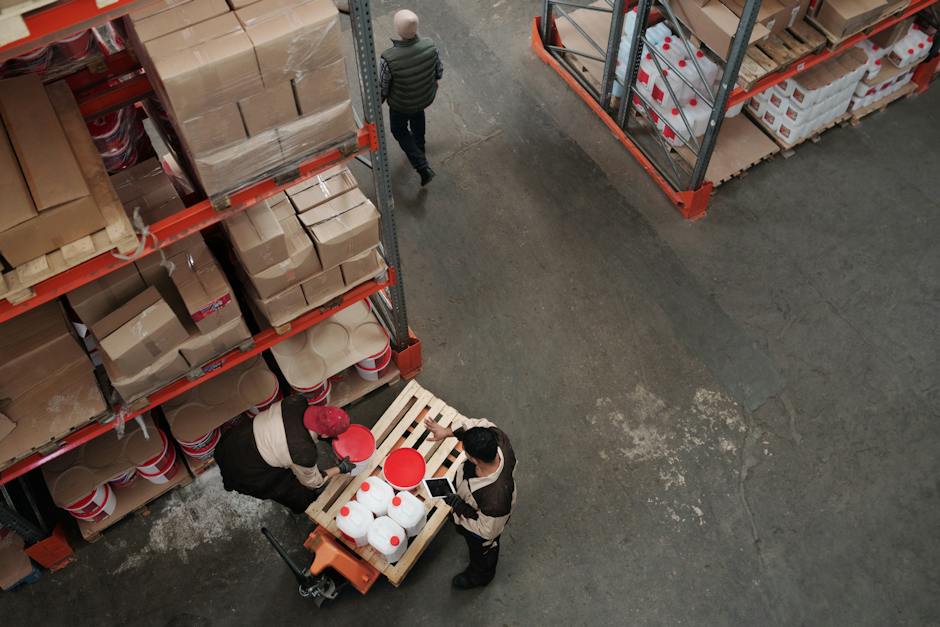In the dynamic business landscape where customer satisfaction is the axis around which services evolve, understanding the intricacies of the packaging and moving services industry is critical. This exploration aids in a comprehensive examination of the existing market, pinpointing key players and their offerings, and identifying differentiating elements. As we navigate this market landscape, we simultaneously unveil unmet needs and previous unheard customer concerns, which could translate into untapped opportunities in the industry. But the discovery doesn’t stop here, as we further infuse novel technology and innovative business models to disrupt standard processing in this realm, and highlight the potential of collaborative networks for creating a comprehensive, satisfying service package. As the adage goes, money makes the world go round, we ensure a deep dive into financial sustainability and return on investment, encapsulating important parameters like pricing strategies, overhead costs, and revenue generation.
Navigating the Existing Market Landscape
Responsive and innovative strategies define the modern landscape of packaging and moving services. Rapid urbanization, a robust e-commerce market, and advancements in digital technology have provoked a challenging but opportunistic scenario for entrepreneurs and businesses.
The aura of digital transformation is infecting every industry, and the packaging and moving segment is no exception. Companies are deploying innovative technologies like IoT (Internet of Things) and AI (Artificial Intelligence) to enhance their operations and customer experience. Furthermore, the adoption of eco-friendly practices, to support the global shift towards sustainability, has stimulated numerous eco-friendly packaging solutions.
Next up, the invasion of the e-commerce industry has amped the expectations of consumers. They crave fast and secure shipping, apart from a delightful unboxing experience. Hence, businesses have begun to pay substantial importance to the look, feel, and functionality of their packaging, which is directly influencing the upside of the packaging and moving services landscape.
When contemplating the moving services sector, the trend of urbanization is significantly shaping its demand and growth. Keeping in mind the rise of expatriates, the shifting of office locations, and the boom in the housing market, moving service providers are hustling to cater with efficiency and superior quality of service. Also, an uptick in the demands for storage and warehouse services is being noted, coinciding with the ebb and flow of the global economy.
However, the real game-changer is the rise of start-ups in the packaging and moving industry. These entities, brimming with disruptive ideas and governed by entrepreneurship, are embracing the modern customer’s need-counts and aligning their strategies accordingly. They are offering end-to-end services, incorporating virtual surveys, video quotes, real-time tracking, and even value-added services like cleaning, setup, and handyman services.
An interesting pattern to note in this sector is the increased implementation of online platforms and mobile applications. Customers prefer digital access to services – from booking, tracking, payment, to feedback. Thus, businesses are focusing on enhancing their digital visibility and interface, to be in line with their tech-savvy customers.
Moreover, the professional networks are also strengthening in this fragmented industry, leading to collaborations, partnerships, and acquisitions with potential stakeholders. It is a smart move to tap into global markets and increase the customer base, thereby gaining an edge over competitions.
In a nutshell, the existing landscape of packaging and moving services is a whirlwind of excitement. With the right tact, agility, and a customer-centric approach, businesses can surf the prevailing waves and create impressive inroads into the future they wish to define. There is limitless potential for those daring enough to innovate, adapt, and continually meet the evolving needs of the global market.

Identifying Market Gaps & Opportunities
In the current market landscape, the packaging and moving industry is swiftly adapting to novel trends and market dynamics. While several influencers have already impacted industry growth and direction, immense opportunities lie ahead which could determine this sector’s trajectory.
One perceivable gap lies within customized solutions. The contemporary customer desires a personalized approach to their needs—be it materials used, design specifics, or timelines. According to a 2017 Forbes report, the demand for customized packaging solutions has risen by 25% over the last two years. Tailoring offerings to individual customer demands not only improves customer satisfaction but also places your enterprise on a superior competitive footing.
Interestingly, moving services can also exploit this gap in providing highly individualized and convenience-centric services. Imagine a world where a customer could track their package/possessions in real-time, predict accurate delivery times, and customize pick-up or drop-off points. This tech-driven perspective would undoubtedly revolutionize the market.
Furthermore, there exists an unrealized potential in developing markets. As urbanization gradually pervades these regions, their corresponding growth in e-commerce and industry will drive demand for both packaging and moving services. Tapping into these frontier markets could ensure unprecedented expansion and profitability for aspirational enterprises.
Another noteworthy opportunity lies in niche segments, such as luxury packaging or specialized moving services for fragile or high-value items. These underserved markets present tremendous opportunity for business that can provide high-quality, reliable, and superior services.
Moreover, the trend of minimalistic designing in packaging is gaining speed. Influenced by the ideology of ‘Less is More,’ customers are displaying increasing attraction towards simple and classic packaging styles, as per the 2020 Packaging Impressions report. Businesses can fuel this trend with creative, eco-friendly materials, and simplistic designs thus creating a superior brand image while also addressing the growing concern for sustainability.
Undoubtedly, integration of technology presents countless opportunities. Leveraging cutting-edge solutions like blockchain could ensure heightened transparency, while automated machinery could boost operational efficiency. Businesses that integrate technology will enjoy enhanced consumer trust and superior market credibility as a futuristic brand.
On the flipside, the challenge for industry players lies in adequately addressing associated risks—be it cyber threat in tech adoption or unpredictable dynamics in frontier markets. However, with a visionary approach, an environment-conscious strategy, and a customer-centric ideology you’d appreciate that these risks also represent potential avenues for innovation and redefining market norms.
In conclusion, the packaging and moving industry stands at an interesting crossroads. Beyond operational effectiveness and cost efficiency, the quest is now for innovative, custom solutions that speak to the consumer’s heart while also addressing environmental concerns. The winner would be the one who identifies these opportunities and bridges the gaps most effectively.

Innovative Solutions in Packaging and Moving Services
Bringing innovative solutions to traditional practices in the packaging and moving industry requires a keen understanding of the business landscape and an aptitude for creative, strategic thinking. The industry is seeing remarkable transformation, driven largely by advancements in technology and changing consumer preferences. Forward-thinking companies are continuously reframing their strategies and redefining their services to stay competitive.
Amidst these changes, customized packaging solutions stand out as a prime example. Consumer preferences are moving towards customized and individual experiences, relationship-building, and high levels of customer service. Packaging, therefore, is no longer just a means to an end; it’s a tool for branding, relationship management, and customer retention.
Further, the moving services have also seen a shift towards personalized, customer-centric approaches. Personalized moving services may include providing easy-to-assemble, modular moving boxes, eco-friendly bubble wrap, wardrobe boxes, or specialized handyman services to help set up new homes.
As businesses are expanding globally, the packaging and moving industry is also witnessing growth in emerging markets. Developing nations with growing middle-class populations represent significant opportunities. The growth potential is vast, offering a slew of opportunities for businesses to introduce meaningful, culturally attuned, and relevance-based innovations.
Another area of progress lies in the emergence of niche segments. Whether it is the demand for luxury packaging options in the high-end retail industry or specialized moving services for unique needs (like art handling or piano moving), these specialized sectors offer substantial market potential for businesses that are more cognizant and driven by specific consumer needs.
In recent years, there has been a significant trend toward minimalist design in packaging. This trend bridges both aesthetic appeal and aligns with the growing environmental conscience among consumers, which demands reduced waste and simpler disposal options.
One of the game-changing factors in the industry is the integration of technologies like blockchain and automated machinery. Blockchain can offer solutions to combat counterfeit products in the supply chain. Automated machinery – whether for faster, error-free packaging production lines or for efficient logistics and moving scenarios – is also becoming increasingly prevalent.
However, the path to innovation is not without risks. Cybersecurity is a real concern and businesses are recognizing the need to develop and integrate robust security strategies. Frontier markets, while promising, are marked by unpredictable dynamics and companies need to strategize accordingly.
Overall, there is a myriad of opportunities for reshaping traditional practices in the packaging and moving industry. The path to market success lies in innovative, custom solutions that prioritize consumer needs, technological advancement, and environmental concerns. Businesses that can adapt and evolve are the ones that will flourish in this dynamic, fast-paced industry.

Building Collaborative Networks
In an entrepreneurial sense, the key to success in any business venture lies not only in understanding your craft but in comprehending the full extent of the marketplace and its potential avenues for growth. For the packaging and moving industry, this entails deciphering how professional networks can help unlock fresh perspectives and unearth untapped opportunities, while providing a strategic advantage in the competitive landscape.
Professional networks offer a rich tapestry of industry knowledge and market insights that can fuel the evolution of packaging and moving businesses. By exchanging ideas, knowledge, and expertise, businesses can unearth potent insights regarding consumer trends, market dynamics, and technology integrations. This knowledge aids decision making, strategy formulation, and ultimately propels both innovation and growth.
Professional networks also fortify a critical avenue—collaboration. In an era where technological advancements swiftly reshape industries, collaborations can be a game-changer. They can facilitate access to resources and expertise that a single business might not be able to harness independently, allowing development of groundbreaking solutions. Take the example of collaborative development of blockchain technology for ensuring secure logistics—a feat that would be near impossible without an expansive and diverse professional network.
Strategic partnerships developed through professional networks can also help businesses to explore and tap into new markets. Emerging markets, rich in untapped potential and growing middle-class populations, can provide opportunities for significant business expansions, while niche segments, such as luxury packaging or specialized moving services, can offer high-value returns.
Professional networks also offer opportunities for branding and customer retention. Through collaborative marketing efforts, businesses can significantly enhance their brand visibility and strengthen customer ties, while benefitting from shared marketing costs—a clear win-win. Emphasizing customer-centric approaches and delivering personalized services can help in building a stellar reputation within these networks, converting into long-lasting business relationships.
However, building and maintaining these networks is not without its challenges. Security-related risks, particularly cyber threats, have become increasingly prevalent. It’s crucial to adopt robust security protocols to safeguard business interests, customer data, and maintain the trust of your network partners.
In conclusion, by fostering professional networks, businesses in the packaging and moving industry can harness a wealth of resources and opportunities. They can pave the way forward with innovative and custom solutions that resonate with consumer needs and environmental concerns, while safeguarding their business through shared knowledge and collaborative strength. Navigating the dynamism of the industry becomes not just about surviving, but thriving—and that’s the essence of an entrepreneurial mindset.

Financial Sustainability and ROI
– Robust financial planning and cost management for ensuring financial sustainability.
Having touched upon industry transformation, consumer-focused strategies, and technological advancements, it’s time to delve deeper into the financial underpinnings of financial viability and ROI.
The packaging and moving industry, like any other, demands robust financial management and cost control practices. Costs, both tangible (like materials, labour, and fuel) and intangible (like brand reputation, customer satisfaction, and emergent technologies), play a pivotal role in shaping a company’s financial prospects. An aggressive yet calculated approach to cost management guarantees not only survival but also the extraordinary growth of enterprises in this industry.
Sound financial planning, therefore, becomes imperative. It comprises budgeting, forecasting, and financial analysis. This allows businesses to allocate resources judiciously, plan for contingencies, and make informed strategic decisions. By embracing cloud-based financial planning solutions, businesses can integrate disparate financial data, streamline operations and gain insights, leading to improved budget accuracy, reduced costs, and enhanced profitability.
– Operational efficiency and quality control for improved ROI
Operational efficiency is another vital cog in the wheel of financial sustainability. It demands the elimination of wasteful processes, the adoption of lean methodologies, and the optimization of workflow. This not only reduces overhead but also improves service quality, leading to customer satisfaction and repeat business.
Quality control, though often overlooked, is linked inseparably to a company’s ROI. Maintaining the quality of packaging materials and ensuring the safe and timely delivery of items can significantly impact a company’s profitability by mitigating the costs associated with damages and returns while enhancing customer satisfaction.
In addition, investment in quality control equipment and training, while initially a cost factor, can yield significant returns by reducing errors, improving productivity, and enhancing customer satisfaction.
– Dynamic Pricing Strategies
Dynamic pricing strategies, based on thorough market analysis and customer data, play a crucial role in optimizing revenues and achieving a robust ROI. A well-implemented dynamic pricing model allows businesses to adjust their pricing based on factors such as demand fluctuations, customer segmentation, and competitor pricing. It helps address customer price sensitivity, maximize price points during peak periods, and increase revenue generation.
It’s essential that businesses in this industry balance financial prudence with the drive for innovation and customer satisfaction. While the operational and financial facets discussed above set the ground for sustainable business models, the eventual differentiator will always be a relentless focus on service excellence and continuous evolution.
Emerging market trends and advances in business and technology are opportunities waiting to be seized. They will shape the future of this industry, driving both competition and growth. Staying ahead will require companies to constantly adapt and innovate, fundamentally intertwining financial robustness and superb customer service in their core business strategies.

Having delved into this vibrant industry’s core, we can now appreciate the complexities and opportunities it presents. The existing market landscape has been unraveled, and potential gaps and chances for innovation within the industry have been identified, signaling the immense scope for creating customer value. The incorporation of technology and innovative business models has the power to significantly disrupt the industry standards and raise the bar for service efficacy and customer experience. Collaboration has been underscored as pivotal, having the potential to create wholesome service packages and even greater customer satisfaction. Moreover, understanding financial sustainability and return on investment in the packaging and moving services industry is foundational to maintaining business health and driving growth. To thrive in this sector, foresight, adaptability, and commitment to service excellence are non-negotiables.

